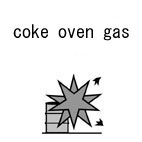| Case Name |
Explosion of coke oven gas during cleaning at a desulfurization regeneration tower of a coke oven gas refining |
| Pictograph |

|
| Date |
May 27, 1998 |
| Place |
Kashima, Ibaragi, Japan |
| Location |
Chemical factory |
| Overview |
An explosion occurred while processing towers for coke oven gas were open. No details are known. If the cause was a reverse flow of coke oven gas from the absorption tower, the problem is that workers assumed the motor-driven valve of a 1-meter diameter could be shut completely. Leakage through the valve should have been predicted. Use of non-explosion-proof electric equipment might have caused the accident, which is also a problem. |
| Incident |
At a desulfurization regeneration tower of a refining unit for coke oven gas, an explosion occurred while sludge containing sulfur and ammonia that had accumulated at the bottom of the column were removed using a vacuum truck.
The refining unit of coke oven gas is equipment for refining coke oven gas through a gas refining process, and separating and refining material such as crude benzene so that remaining gas can be used as fuel gas. |
| Processing |
Manufacture |
| Individual Process |
Maintenance |
| Substance |
Coke oven gas |
| Type of Accident |
Explosion |
| Sequence |
Since May 11th, 1998, the desulfurization regeneration tower was stopped to clean the bottom.
9:40 on May 27th, an explosion occurred at the bottom part of the tower while sludge containing sulfur and ammonia was removed by a vacuum truck. |
| Cause |
On removing sludge from a regeneration tower, it is essential that a liquid seal of the coke oven gas line and closing the valve are executed properly. In this case they were insufficient. Coke oven gas remained in the absorption tower, which was directly connected to the regeneration tower. There was a main liquid line with a diameter of 1 meter between the absorption tower and the regeneration tower, and branch piping with a diameter of 150 mm went back to the regeneration tower. Shutting off the two towers was executed by closing one motor-driven valve of the main line, and maintaining the liquid head in the branch piping by closing a motor-driven valve.
The cause of the accident has not been determined yet. If the information in the Hazardous facility safety promotion workshop's textbook, which is listed in "information sauce", is reliable, the motor-driven valve might not have been closed completely, the liquid leaked slightly, the liquid seal in the branch piping broke, and coke oven gas flowed into the regeneration tower. Therefore, the coke oven gas possibly ignited due to sparks from a floodlight plug or an electric bulb. |
| Response |
Spraying water for cooling the inside and outside by using fire extinguishers. Then it was sealed with nitrogen. |
| Knowledge Comment |
Any potential hazard should be eliminated. |
| Background |
The security of this work was based on the assumption that there is no leakage at the valve of 1-meter diameter pipes. If there was valve leakage, the water seal could be broken and combustible gas could flow in. As a practical problem, possibility of valve leakage should have been considered. Besides, the leakage needs to be taken into consideration because the pipe with a diameter of 1 meter is big enough. Operators overestimated equipment security, which caused an inadequate judgment. It would be impossible to shut off the facilities containing combustible gas and open air facilities by closing only one valve at all times. |
| Incidental Discussion |
Valves sometimes leak and the check valves can cause a reverse flow. Although safety measures should be taken based on the consideration described above, this is sometimes forgotten. |
| Reason for Adding to DB |
Example of explosion caused due to lack of hazard prediction |
| Scenario |
| Primary Scenario
|
Poor Value Perception, Poor Safety Awareness, Inadequate Risk Recognition, Organizational Problems, Poor Management, Poor Operation Management, Ignorance, Insufficient Knowledge, Convincement, Planning and Design, Poor Planning, Poor Shutdown Planning, Malicious Act, Rule Violation, Safety Rule Violation, Bad Event, Thermo-Fluid Event, Reverse Flow, Secondary Damage, External Damage, Explosion, Bodily Harm, Death, Bodily Harm, Injury, 5 person injured, Loss to Organization, Economic Loss, Manetary Damage 20 million yen
|
|
| Sources |
Fire and Disaster Management Agency, Explosion in absorption tower of gas refining unit, Accident cases of dangerous materials, 1998, pp.44-45
H. Ishiyama, Explosion in absorption tower of gas refinery, Hazardous facility safety promotion workshop's textbook, p.17-44(1999)
High Pressure Gas Safety Institute of Japan, High-pressure gas protection overview, 1999, pp.147 (2000)
|
| Number of Deaths |
1 |
| Number of Injuries |
6 |
| Physical Damage |
Damage to external walls of adjacent buildings and windows. |
| Financial Cost |
¥ 18 million (Fire and Disaster Management Agency) |
| Notes |
As the effects of the explosion did not spread outside the factory, the only emissions into the environment were coke oven gas and ammonia gas. Neither both emissions would affect the environment. |
| Field |
Chemicals and Plants
|
| Author |
WADA, Yuji (National Institute of Advanced Industrial Science and Technology)
YOSHINAGA, Jun (Graduate School of New Frontier Sciences, The University of Tokyo)
TAMURA, Masamitsu (Center for Risk Management and Safety Sciences, Yokohama National University)
|
|